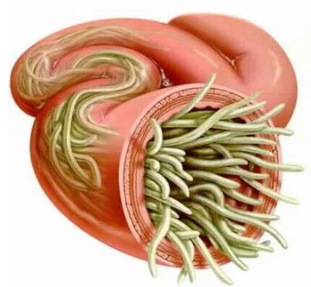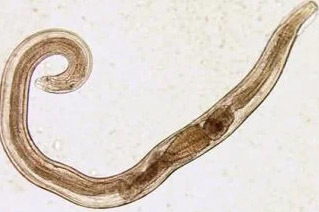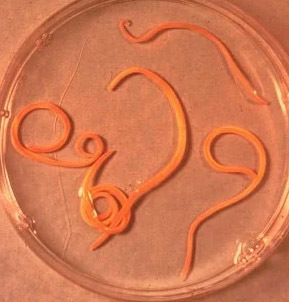Today the science knows the order of 280 species of worms, able to develop and live in the human body, the disease in the different organs and tissues. The frequency of infection of worms of a person depends on the climate and the socio-economic conditions specific to the territories (in the underdeveloped countries, especially in those that are found here in the tropical zone and subtropical zone, the level of parasitic infection is significantly higher than that in the rich countries).
Ways of transmission of the person the worms:
- Bioelements (infection of animals).
- Contagious helminthiasis (transmitted from person to person).
- Geohelminths (diseases caused by parasites, behind one of the cycles of life on earth).

Factors that influence the manifestation of worm infections
The method of the penetration of the parasite in the body:
- The adaptation of worms to the human body;
- The density of the population (the number of) infected individuals;
- The place of the dwelling of the worm (fabric parasites inhabit in the thickness of the soft tissues, and translucent live in clearings of the bodies hollow). Some helminths in different stages and translucent, and the fabric of the form. The larvae and the development of the phase of worms, as a general rule, cause more pronounced pathological changes.
In the absence of a new infection by the number of adult parasites in the human body, does not increase. This feature distinguishes it from infestations of diseases caused by bacteria, viruses, fungi and protozoa organisms.
Worms in man: symptoms
Helminthiasis is a disease that is characterized by 2 current phase of the acute, from two weeks to two months) and chronic (several months to several years).
The symptoms of the acute phase of helminth infection
The first signs of the disease may appear at different times (especially through 2-3 weeks, when ascariasis – over 2 or 3 days and when filariose the incubation period can last from 6 to 18 months).
In the acute phase of parasitic infestation most characteristic symptom is an allergic reaction (occurs the creation of antibodies to antigens of species of larval parasites). Often infected by worms of the people in the skin appear rashes with itching, inclined towards the retidiviruuschem current, increase the lymph nodes, you may experience generalized or local edema, muscle and joint pain with guided. Also the migration of the larvae of the parasite, can cause pain in the chest, coughing, attacks of asphyxia, disorders of the chair, nausea and vomiting.
At the same time, the acute phase of helminth infection may be accompanied by more serious offences (serious forms of pneumonia, hepatitis, myocarditis, allergic, hepatosplenomegaly (enlarged liver and spleen).
In the blood, increases the number of eosinophils (eosinophilia) and disrupts the normal quantitative relationship between protein factions (dysproteinemia).

The signs of chronic helminth infection
The symptoms of chronic phase depends directly on the type of body "inhabited" the parasites, as well as the important role of its dimensions and the quantity.
Thus, when the parasitism in the intestine of isolated individuals of the disease can be asymptomatic (with the exception of the cases of infection very large, parasites). Characteristics of the chronic phase of intestinal helminths are dyspeptic disorder. Children more pronounced asthenoneurotic syndrome and pain. The massive invasion of the Ascaris, it is possible the development of intestinal obstruction, mechanical jaundice and pancreatitis.
The consumption of all the components necessary for their sustenance from the substance of the body of the master, helminths become the cause of digestive disorders, poor absorption of vitamins, minerals, carbohydrates, proteins and fats. At the same time, the products of the vital activity of the worms inhibit the ediacarense normal gut and reduces the immune strength of the body.
People who suffer from helminthiasis, due to alterations of immunity, and the intensification of the process of cell division (ongoing research into the recovery of parasites from tissues) significantly increases the risk of occurrence of malignant tumors.
Species of helminths, infect humans
The pathogens of helminth infection on human are 2 types of worms: round (nematodes) and flat (tape and flukes).
Nematodes
Pinworms
The parasites, which are a cause of enterobiasis are small (up to 10 mm), thin abdominal worms, have greyish-white spots. The infection occurs in digestive tract through the mouth). – Due to dirty hands. The eggs of the parasite can be on the earth, in the fur of the animals infected, unwashed fruits and vegetables, etc, however, when enterobiasis cases samsarajade (especially in children), derived from the scratching pastes, and areas subsequent to the ingestion of eggs. The larva of the ostritsy is developed during two weeks in the digestive tract. Becoming the kind of adult worm parasite in the departments lower fine and higher, of the departments of colón.

Ascaris
Ascaris is a parasite fusiform shapes of red and yellow, reaching into adulthood, 40 cm (females) and 15 to 25 cm (males). Not having suction cups or other attachment accessories, Ascaris is able to move independently to the meeting of the food to the masses. Eggs, earrings of the female parasite, stand out together with the stool.
The infection ascariasis occurs in the case of ingestion of the maturity of the eggs together with the water or dirty fruits and vegetables, which have soil particles. After the penetration of the eggs in the intestine they come out of the mature larva. Then, infiltrating the wall of the colon, of them, the flow reach the heart, and from there reach the lungs. Through the pulmonary alveoli larva ascaride of the respiratory tract, penetrates into the oral cavity. After returning to the ingestion of a parasite reaches the small intestine, where it develops in the species adult. The worm lives over the course of 12 months, then it dies and is excreted together with the stool. In the intestine of a teacher can live as a single, and several hundred copies.
Vlasoglav
Vlasoglav, the causal agent of trichuriasis, is worms color white, parasitic in the beginning of the division of the large intestine and reaching the size of 4-5 see the parasite Feeds on blood and tissue of the rectal mucosa.
The eggs whipworm, pending the female of the wall of the colon, out to the street along with fecal masses. Its development occurs in the environment (optimal on the ground). Eggs mature in them the larvae of the parasite enter the body digestive, through the hands dirty, with water or without washing the fruits and vegetables.

Trichinella
The causative agent of trichinosis is a small, round worms that reaches 2 to 5 mm in length. The infection occurs when the consumption of poorly roasted meat (pork, bear meat, wild boar or). Penetrating in the intestine, the larva of the parasite for 3-4 days arrive to make it to the state of Mature of the species. The duration of the life of the worm is of 40 days, after which the parasite dies. Favor of the intestinal wall, the larvae penetrate the bloodstream and are disseminated by all the organs of the human body, staying in the muscles. In this case, the more often surprised with the breathing and facial muscles, as well as the flexor muscles of the extremities.
In the early days after the invasion of the patients complain of abdominal pain. Then, after about 2 weeks, the body temperature increases up to 39-40 With the, on the skin appear rashes with itching, develop muscle aches, swollen person. In this period, in the case of mass infection, there is a risk of death. After a month of recovery begins. The parasite is encapsulated in the form of a spiral, after that in the period of two years dies.
(Ancylostoma and necator
These two parasite are similar to each other by biological characteristics, as well as by the recipient of the disease. With respect accepted the uniting under the general title (hookworm). The worms, which reach a length of 10-15 mm, parasites of the 12 p. gut. It should be noted that this is one of the most common, but, at the same time, enough rarely identified the parasites. The larvae of the worms enter the human body through the epidermis in case of contact with the infected soil. In addition, enter the bloodstream, which, as well as the ascaride, they migrate to the lungs and then through the bronchi, along with otharkivajushche phlegm – digestive system. (Ancylostoma parasite in the intestine, attaching itself to the intestinal wall. The parasite, eat only blood, the bites of stinging of the mucous membrane of the blood vessels, jets there, the anticoagulation component. During the day, of the species, adult, on average, can absorb 0,05-0,35 ml of blood. Therefore, the most characteristic symptom of this worm infections is iron deficiency anemia, as well as the change of the correlation of the protein fractions (dysproteinemia).
The flatworms
The choice of lentets
It is one of the largest worms, reaching a length of 10 to 20 meters. The disease is caused by the data of a parasite called difillobotrioz. The development cycle of the worm starts with a freshwater fish or rachkov. In the human body, which is the ultimate owner of a wide lentetsa, the larva enters along with the caviar or infected fish fish fillets. Reaching the small intestine, the parasite attaches to the wall and in the period of 20-25 days grows to a Mature species.
Liver Fluke
The parasite that causes opisthorchiasis is a flatworm, reaching a length of 7 to 20 mm, it should Be noted that more than 50% of the cases of infection liver Flukeom (known as feline Fluke are the inhabitants of russia. The larvae of the parasite, they begin to develop after the exposure of the eggs in fresh water (to swallow your snails). In the future, penetrate into the body of the fish (carp, crucian, bream, roach). Human infection occurs by ingestion of infected foods no meat, fish, has not passed sufficient heat treatment. The larva of the liver Flukey of small intestine penetrates bile in the ducts and in the gall bladder, the fixation of there with two suction cups.
Of bovine and swine tsepen
These are almost identical in their structure, the parasites reach the length of 5-6 meters. The infection beef tapeworm infection and taeniasis occurs as a result of the consumption of beef, veal or pork infected finns (one of the intermediates of helminthiasis). Viable to the finns, presented in the form of whitish bubbles, reaching a size of 0.5 cm, are fixed to the wall of the small intestine of man and in 3 months you will become the kind of adult. The tape parasite, consisting of over 2000 segments, constantly grows. At the end of the segments, which contain eggs, are raised and moved independently of the colon to the anal hole, and then reptan of the anus, or stand out in the outside environment along with the feces. More typical symptoms of helminthiasis is the violation of working in the digestive tract.
Echinococcus
For this parasite, man is the intermediate of the owners. Worm parasite in the human body, in the form of the finns. The definitive owner equinococo – the wolf, the dog or cat. The infection occurs in the digestive through contact with animals and with objects in the environment, the planting eggs equinococo. After entering the intestine of them are developed oncospheres (shestigrannye the larvae). Intestinal, that penetrate in the bloodstream and are disseminated throughout the body.
Alveolar
This parasite, which is believed to be a variant of the equinococo, is the cause of one of the most dangerous of helminths (of alveococcosis), that by the severity of incidence is similar to cirrhosis and liver cancer. The infection occurs by the penetration of oncospheres (eggs and mature larvae in the intestine. There the germ comes out of the eggs and, infiltrating into the intestinal wall, enters the bloodstream. In addition, with the current of the blood parasite is distributed to all tissues and organs of the body (often located in the liver). There, near the larvae begins the development stage (forms multi-camera bubble, labrocyte). In each cell contains embryonic head of the parasite and of the growing development gradual. The eurocity is very aggressive to the training, always on the increase thanks to the expansion of the bubbles, as well as with the ability to germinate in the liver, as the cancer metastasis.
The diagnosis of helminth infection
The diagnosis of worm invasions includes the following activities:
- a careful history helps to find out the possible causes of the infection;
- laboratory studies of stool, blood, content, 12p of colon, rectal and perianal mucus, muscle tissue, phlegm, bile. In the analysis you can detect the eggs, segments or fragments of parasites. However, a high eosinophil count in the blood is also a sign of the presence of helminths.
- in the diagnosis of diseases caused by the larval stages or filters parasites, are made are the serological tests (elisa, rac, the reaction of indirect agglutination, immunofluorescence analysis, etc).
- for the detection of helminths that affect the liver tissue, is assigned to the ultrasound, ct and endoscopic research.
Worms in man: the treatment of the
In the acute phase reruiters of infection to the patient is assigned to dezintoksikatsionnaya the and desensitizing therapy. When the heavy weight of current of disease (the trematode liver, trihinellez) treatments, the indications for glucocorticoids are used.
As medications specific therapies, taking into account the nature of the pathogen are assigned special pprotivogelmintnye chemotherapeutic agents.
In parallel to the sick it is recommended that the reception of antihistamines and enterosorbents. The final stage of treatment includes the use of probiotics, standardize the ediacarense of the intestine.
It is also assigned to a special care of the diet (food must be legkousvoyaemoy and contain less fat).
In the period pprotivoglistnoe of the therapy the patient requires strict adherence to personal hygiene to avoid re-infection). At the same time, when many helmintiasisx the treatment must be passed by all members of the family, and the people infected are in permanent contact.






































